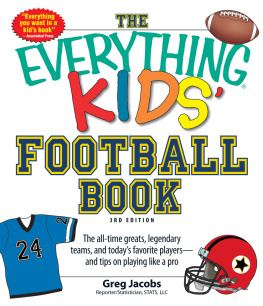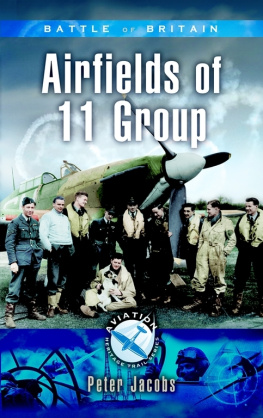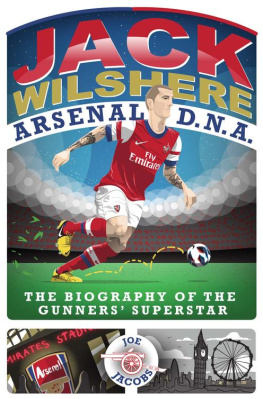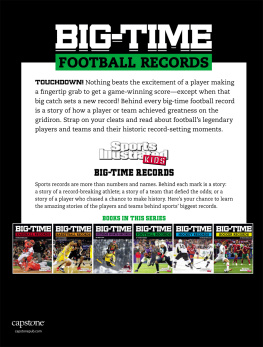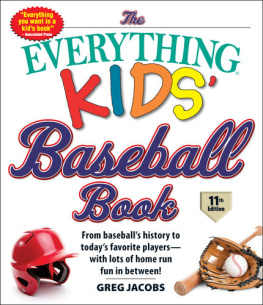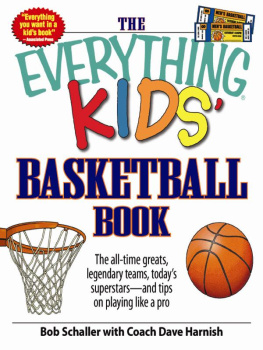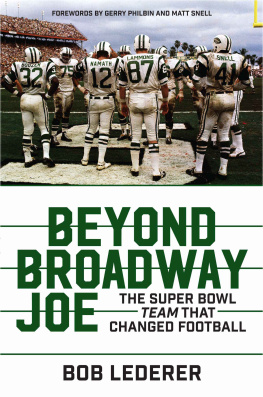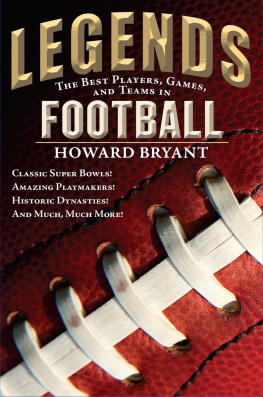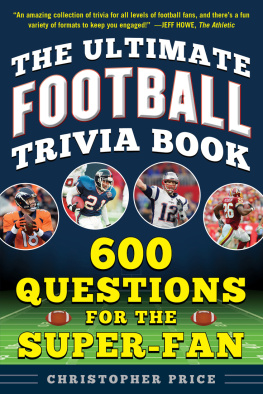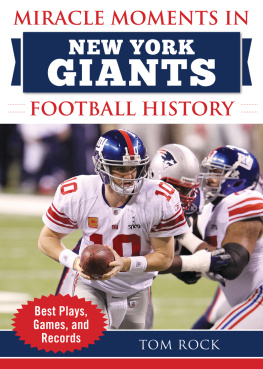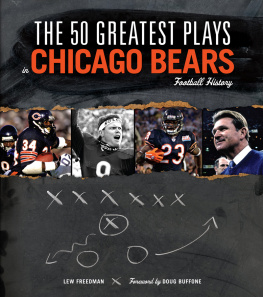
FOOTBALL
BOOK
3RD EDITION
The all-time greats, legendary teams, and todays favorite playersand tips on playing like a pro
Greg Jacobs, Reporter/Statistician, STATS, LLC

CONTENTS
ACKNOWLEDGMENTS
I only get a few lines here, so I cant fully express my appreciation to all of these folks. But copious thanks anyway to: Bart and Mary Ann Jacobs, the late Jack Soete, Peter Cashwell, Clint Alexander, Keith Johnson, Gene Ware, David Glover, Brad Spider Caldwell, the Penn State football program, Andrea Bell, Kerry Smith, Grace Freedson. And, to my wife and sidekick Burrito Girl, a.k.a. Shari Jacobs, who lets me watch football on the big-screen TV all season. Shes the best.
DEDICATION
To Milo Cebu, who likes cows, so perhaps will become a Texans fan
INTRODUCTION
W elcome to the third edition of the wildly popular The EverythingKids Football Book!
So much has happened in the two years since the second edition came out. The Packers won their fourth Super Bowl; the Giants beat the Patriots again for their second Super Bowl win in the past four years. Alabama and LSU made the SEC seem to be the best conference in college football, yet again. And Tim Tebow of the Denver Broncos has changed the way NFL offenses move down the field.
Whether you know a lot about football or hardly anything at all, this book has something to offer you. If youre relatively new to football or if youre looking for new ways to play, talks about the people who make big contributions to the game behind the scenes. In this edition is a description of how scouts and statisticians help teams win, and help fans follow the game. There is also advice on starting and running your very own fantasy football league.
If youve mastered the basics of football or want to learn more about the Xs and Os, there are two chapters to help you: one about offense and one about defense. Hopefully, this book will be able to teach you something about football, no matter what you already know or dont know. Enjoy!
Chapter 1
PLAYING THE GAME
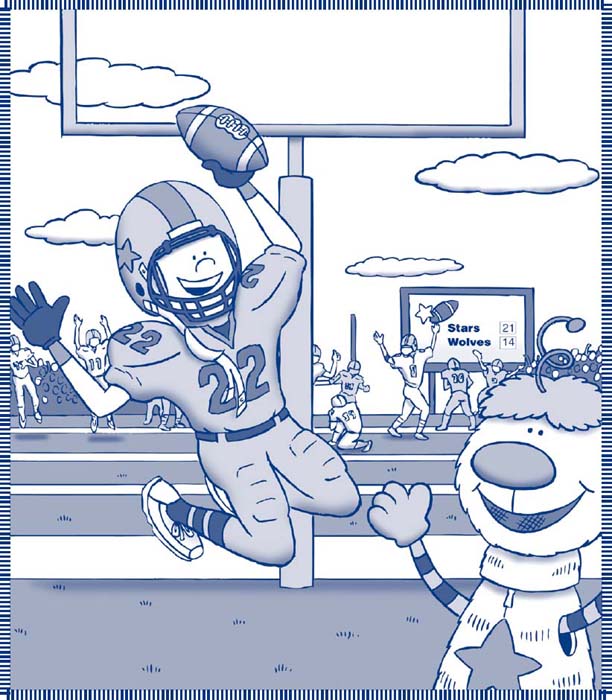
Where Did Football Come From?
In most countries other than the United States, when people talk about football they mean the game we call soccer. Here in the United States, football actually means football, as in the game you play with a brown, oval-shaped ball.
For most of history, people have played games with balls and goals. At least 500 years ago in England, the game we call soccer developed. In soccer, players try to put a round ball into a goal without using their hands.

NFL: NFL stands for National Football League. The NFL consists of thirty-two teams across the country that play televised games each Sunday in the fall.
In the early 1800s, players at the Rugby School in England started cheating. Instead of kicking the ball, they picked it up and ran with it into the goal. Some teams liked to play against the Rugby Schoolthey just tackled whoever picked up the ball! Other teams wanted to play soccer the normal way. Soon two separate forms of the sport were played. In rugby, players were supposed to run with the ball, and defenders were supposed to tackle the ballcarrier to the ground.
Americans picked up the game of rugby, but every team wanted to play by different rules. In the late 1800s, several colleges and athletic clubs in America played games similar to rugby. East Coast schools such as Princeton, Rutgers, Harvard, and Yale eventually got together to try to standardize the rules.
By the turn of the century, American rugby had changed enough that you probably could have recognized the game as football. Every play was a running play. Blockers (without much padding) slammed into each other as hard as they could. There were so many injuries, in fact, that many people tried to ban the sport. At the personal request of President Teddy Roosevelt, Yale athletic director Walter Camp led a commission that created a more exciting and less dangerous game than had been played before. It was Camp who insisted that eleven players was the right number for a team. He invented the idea that the offense had to gain yardage to get a first down. Most importantly, Camp revolutionized football by inventing the forward pass.
College Football
College football in the early 1900s was dominated by the northeastern colleges that are now part of the Ivy League. In fact, it was 1912 before a nonIvy League school won a national championship. Collegenot profootball was the popular spectator sport through the first half of the 1900s. Colleges throughout the country formed teams, and more and more people started watching and playing football. The college bowl games on New Years Day were the highlight of each season.
In the 1920s, colleges all over the country played football. Professional teams had started playing in the Midwest. Both the pro and college games were well known and well followed. However, football didnt become the big deal that it is now until after the Great Depression and World War II.

TV Makes Football Popular
In the 1950s, most people could afford TV sets at home. Television networks figured out that people loved to watch football. Televised football made the game even more popular and provided a good deal of money for team owners. The Super Bowl, first played in 1967, became the most important sporting event in America. Fans enjoyed watching their favorite college players competing for many years as professionals.
Nowadays, youll see both college and pro football on TVcollege on Saturday, pro on Sunday. Many college teams and almost all pro teams sell out their stadiums every week. High schools and youth leagues stage games each week as well, giving more people a chance to play the game.
Football GREAT
George Papa Bear Halas
George Halas played for the company football team at a starch plant in Decatur, Illinois, in the 1910s. Under his leadership, his company team became the Decatur Staleys of the National Football League. He moved the team to Chicago and renamed it the Bears in 1922. Halas ran pretty much the entire Bears organization: he played, he coached, he recruited, and he even sold tickets! In recognition of Papa Bears contributions to his team and to the NFL, the Bears uniforms show Halass initials, GSH, on the sleeve.
Rules of the Game
At first glance, footballs rules seem very complicated. The official rulebook is more than 200 pages long. In any game that you watch, youll probably see at least one play when the announcers arent quite sure why a referee made a call. But you dont need to understand every little detail to know how to play. Just know the basics, and youll figure out the complex stuff over the years.

